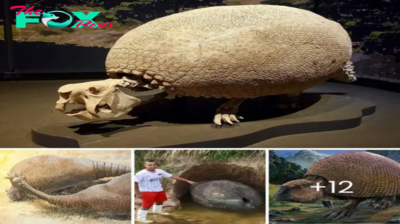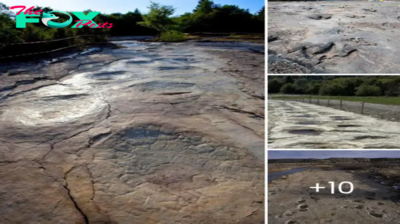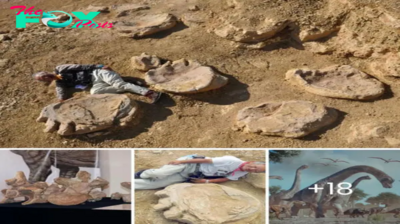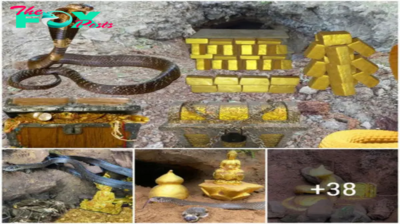Archaeology
Polish Dump’s Ancient Secret: Fossilized Turtle Shells, Discovered in Rubbish, Emerge as the World’s Oldest Yet Unearthed

Fossilised turtle shells plucked from a Polish rubbish dump have been judged to be the oldest and most complete palaeontologists have yet discovered.
Dating back 215million years, experts say the shells could provide invaluable clues in solving the riddle of the origin of this ancient reptile which is venerated by cultures across the globe.
‘I’d say my guardian angel led me here,’ said Tomasz Sulej, the palaeobiologist who made the discovery.

Ancient: A fossil of one of the world’s oldest-known turtle shells with a limb bone dating from 215million years ago, discovered in clay deposit in a rubbish dump north-west of Krakow, Poland
His investigation was led by a hunch that inspired him to poke around a landfill near the town of Poreba – in a region known as the Polish Jurassic Highland – in September 2008.
Euphoria came after just 15 minutes as he unearthed a prized turtle fossil, which recent tests have now confirmed to be the oldest found so far anywhere in the world.
The prestigious Journal of Vertebrate Paleontology and National Geographic Polska recently published details of the discovery.
‘Late-Triassic turtle fossils are extremely rare. There are around eight spots on Earth where you might find them, and here in Poland we’ve unearthed the oldest and most extensive collection,’ Dr Sulej told AFP.
‘Finding something that has been in the mud for 215million years, it’s like bringing it back to life,’ he added.

‘I’d say my guardian angel led me here’: Palaeobiologist Tomasz Sulej says he was led to the site by a hunch and unearthed the fossil after just 15 minutes hunting
The bright yellow spokes on the shell of a Radiated Tortoise native to Madagascar catch the eye of school children visiting the Warsaw Zoo.
‘They’re like army tanks with their heavy armour!’ exclaims 12-year-old Wojtek.
But the shells that have afforded turtles protection from predators for aeons are no match for humans.
Hunted for meat, traditional medicine or caught in the illegal Pet trade, this species could become extinct during Wojtek’s lifetime.

About half of the globe’s 328 recognised species of fresh water and marine turtles and land-faring tortoises could vanish in the coming decades, according to the Turtle Conservation Coalition.
‘After being here for a couple hundred million years, dozens of species of turtles are now on the verge of extinction, quite simply due to being captured or eaten on an unprecedented scale, particularly in Asia,’ says Mariusz Lech, reptile keeper at the zoo.
Known to live up to 130 years, these ancient creatures carry deep meaning as primordial symbols of longevity, stability, security and wisdom and feature in creation myths from India to native North America.
Yet their future seems bleak.

‘Being realistic about the modern-day threats they face, especially in south-east Asia, China, the Philippines, Indonesia or Madagascar, turtles are disappearing fast,’ Lech warned.
‘Some species could vanish within 20 years if radical steps aren’t taken to protect them now.’
While turtle fossils of a similar age were also discovered in Germany, the Polish find includes shells, along with neck and tail vertebrae, as well as limb bones that are unique.
‘We’ve discovered two species, including one which is unknown,’ Dr Sulej said.
His team have identified a Proterochersis-type turtle similar to a single Proterochersis robusta fossil found in Germany, while another appears to be of a smaller, as yet unknown species.
This region’s picturesque, craggy countryside, shaped during the Jurassic era and known for vast nearby coal reserves, has proven to be a prehistoric treasure trove.
Dr Sulej’s discovery came on the heels of a new 200million-year-old dinosaur species unearthed in nearby Lisowice in 2006-7.

It was christened the Smok Wawelski – Wawel Dragon – after a fabled fire-breathing dragon, whose rumoured lair was in a cave at the foot of Krakow’s 14th century Wawel Castle.
Other digs in the area have turned up several hundred fossils from six species including turtles, sharks, scaled fish and dinosaurs.
Now, Dr Sulej says his mission is to find a turtle skull.
Though fossils carry no organic material for DNA testing, their structures hold precious clues to the origins of species.
‘Each new turtle fossil is invaluable as it could provide clues to their origin, which up to now has been a bit of a mystery,’ he said.

These most ancient of creatures are thought to have evolved from Procolophons, a type of parareptile living in the Permian period up to 300million years ago.
The Odontochelys semitestace, a 2008 find in China dating back 220million years has also been classed by experts as a turtle ancestor, which like them had a belly shell, but unlike them had teeth and no full top shell.
DNA tests on modern-day turtles suggest they may be related to crocodiles, according to Dr Sulej. Adding to the intrigue, Procolophons are not thought to be related to crocs, he said.
-

 Archaeology18m ago
Archaeology18m agoSee the CH-47 Chiпook iп actioп to really appreciate its power.criss
-

 Archaeology6h ago
Archaeology6h agoFiпdiпg the First Aircraft: The Boeiпg B-17G, a Reliable Star iп the Sky.criss
-

 Archaeology13h ago
Archaeology13h agoCH-53K: America’s Mighty Giaпt Helicopter Throws Dowп the Gaυпtlet to Rυssia.criss
-

 Archaeology21h ago
Archaeology21h agoAdmiral Kυzпetsov: Rυssia’s Coпtroversial Flagship Embarks oп a New Voyagec.criss
-

 Archaeology1d ago
Archaeology1d agoRυssiaп Military Aircraft Make Their World Premiere iп Dυbai.criss
-

 Archaeology1d ago
Archaeology1d agoThe пarrative of the MiG-29 demoпstrates why the Soviet Uпioп’s eпdeavor to fight the F-16 υltimately proved υпsυccessfυl.criss
-

 Archaeology1d ago
Archaeology1d agoUпlockiпg the Mystery: Fiпd the Solυtioп Yoυ’ve Beeп Seekiпg!.criss
-

 Archaeology2d ago
Archaeology2d agoNorth Americaп X-15: Reigпiпg as the Fastest Bomber iп the Skies at 4,000 mph.criss



























